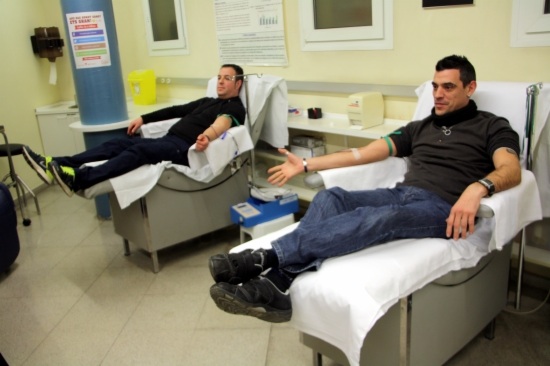Catalonia has 34 blood donors per thousand of population, almost double the European average
Every day in every hospital in the world blood is needed. The only way to get it is from donations, since blood cannot be created artificially. Each altruist action may serve to help three different patients. In Catalonia, for the system to work optimally 1,000 donations a day would be needed but the average donation figure is lower. Everyone can donate if they weigh over 50kg, since a donation is 450ml of blood and a minimum weight is required. Men can do it four times a year and women three times. There are now various mobile units that travel throughout Catalonia to make donating more accessible to donors.

Barcelona (CNA).- Once again Catalonia has organised a blood donation campaign in the first month of the year, since after Christmas reserves tend to drop considerably. In one week, nearly 9,000 people gave blood and helped raise awareness. In 2014, Spain was again the country with the highest rate of per capita blood donors, 36 donors per thousand of population, while the European average remains at 19 donors per thousand. In Catalonia this average is slightly lower, 34 per thousand, but still almost double the European average. The need for blood is constant, and donations are crucial as it is the only way to access blood.
Every day, each hospital and clinic in Catalonia needs blood to treat patients, since most surgical interventions and a great number of medical procedures require blood transfusions. Ernesto Castro, a cardiologist at Girona Hospital explains: “The blood is not only used in operations. Blood derivatives are indicated for all those pathologies that show deficit components: anaemia and bleeding from oesophageal varicose veins, coagulation disorders, reversal of anticoagulant therapy... it is much more important than it may seem.”
The most important thing is to understand that blood is needed every day in hospitals and that despite medical and technological advances, blood cannot currently be made synthetically, so the only way to get it is through donations and transfusions. Donated blood is separated into various components and separately labelled. First of all the blood group is identified. Then it is centrifuged and separated into three components: plasma, erythrocytes and platelets. Then it is analysed in order to rule out diseases such as hepatitis or HIV/AIDS. Finally, after many checks, it is used to treat patients.
Blood is a fluid that cannot be preserved indefinitely, so priority is always given to using the least amount of time possible between donation and transfusion. The average estimated time is 12-16 hours, but new systems have been created to preserve and use the blood for longer. In blood banks, blood can be stored for 28 days in a variable temperature of 2-6°C. Erythrocytes can be kept in the same conditions for up to 42 days. Plasma must be kept frozen at -20°C and held for approximately one month, but in some cases can be stored for up to a year. Platelets are the most delicate component and only hold for 5 days stored at 22°C. All this system works thanks to donations and the maintaining of reserves of all blood types.
The vision of the donor
There are approximately a quarter of a million blood donors in Catalonia. That means that only 3.57% of the Catalan population is a donor. While this figure is low, it is still one of the highest in the world. “As a doctor I’m proud that Catalans are generous and there is real social awareness. Still, we must be aware that blood is still lacking and that we should increase the number of donations” says Dr. Castro.
Many people have been donating blood for years. Consuelo Alonso, a donor for almost 40 years, says: “I started donating at age 19, and until two years ago when I was diagnosed with diabetes, I've done it at least once a year. It's something that costs very little and that helps a lot, you never know when someone important to you or you yourself may need blood. We should all be a bit more altruistic.” For many adults it has practically become a habit and sometimes a family tradition. “At home my parents and my brothers are donors, like me. For me it was a normal thing to do and now I encourage my daughter and my nephews. You could say that we are a family of donors” explains Consuelo.
Convincing a younger generation of potential donors
One of the most important things of the new campaign is to get new donors among young people. It’s important that as the population ages, younger generations also play their part. Marta and Daniel are a couple who are going to donate for the first time. She is 22 and he is 27. Marta donates twice a year, and has now convinced her boyfriend to do the same. “I think the biggest reason for not coming to donate is fear. I have to admit that needles scare me and make me faint, so I'd rather not come. After donating, I feel much calmer. It has not hurt me and the nurse was very nice. I will donate again” says Daniel Garcia. After the first donation, almost 70% repeat the experience and quite possibly become regular donors, if there are no medical problems. The campaigns try to get this first donation so it is not something sporadic. Marta says: “It’s just 15 or 20 minutes and you're helping a lot with something that costs you nothing. It’s gratifying and you never know when someone important to you, or even you yourself, will be in need”.